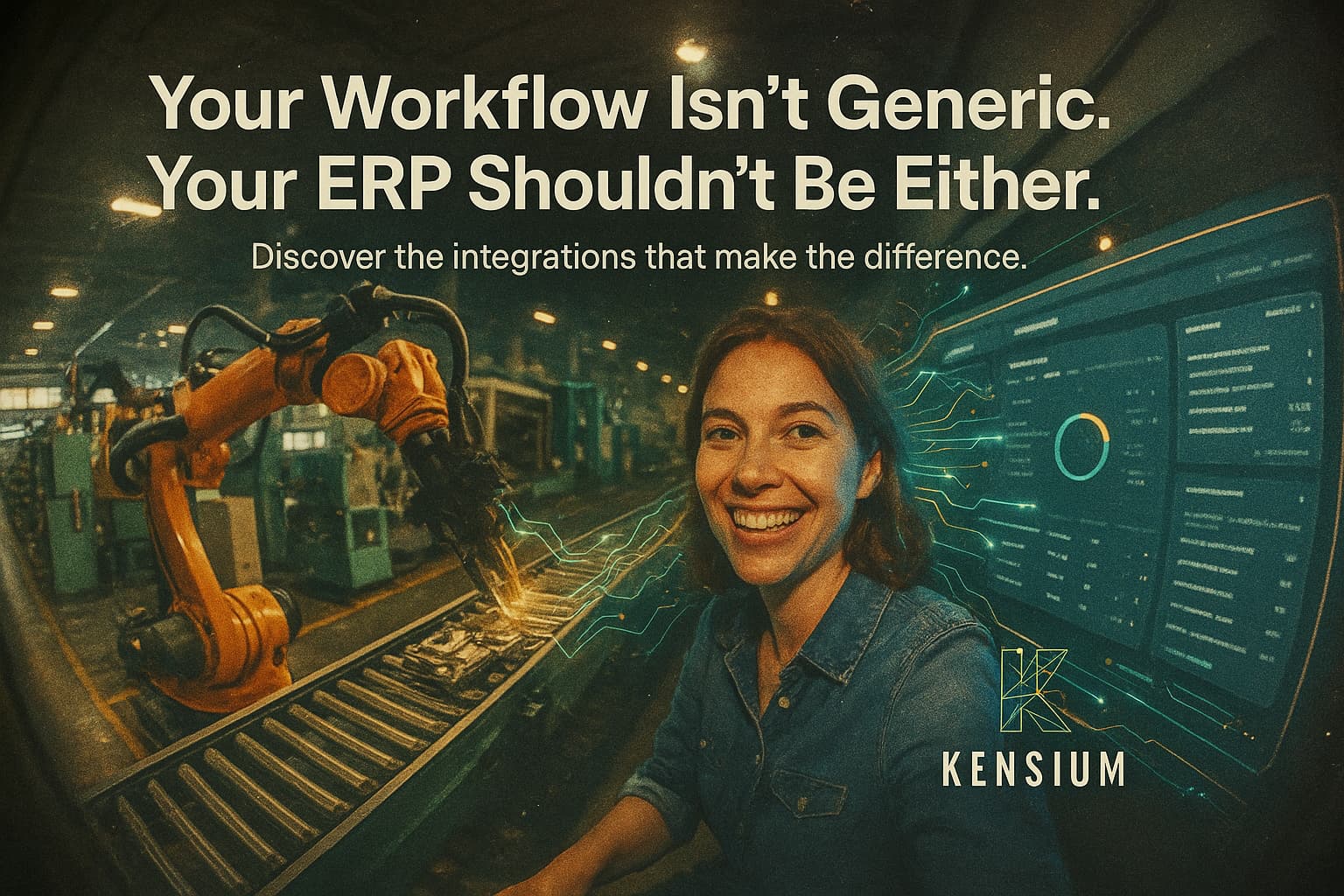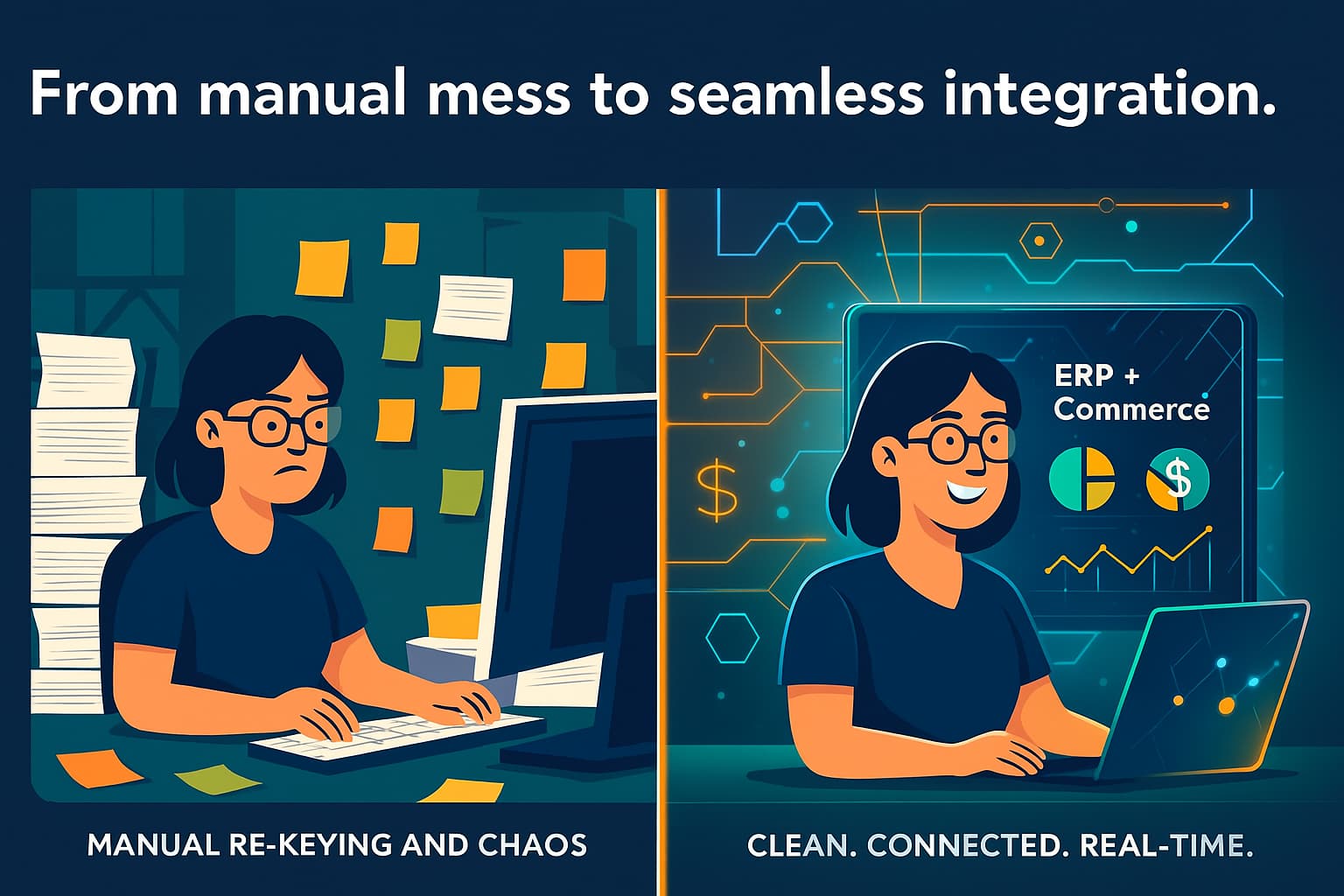
Modern manufacturers often feel bogged down by legacy ERP systems – monolithic, costly platforms that should run everything but instead create silos and delays. Outdated on-prem ERP can stifle innovation and growth: as one Shopify guide notes, “software bought years ago may no longer support the company’s business model and can hinder innovation”[1]. In fact, 94% of companies say timely innovation is critical, yet old ERP makes it hard to adapt. One cautionary tale: a large retailer spent 7 years and $500 million trying to switch from its custom system to SAP, only to scrap the project because it couldn’t fit their workflows[2]. These stories are all too common in manufacturing – the big ERPs are powerful but often too powerful, forcing complex change management, heavy maintenance and massive license fees.
The Legacy ERP Trap
Many small and mid-sized manufacturer send up “trapped” by their ERP. These systems deliver every module under the sun – but most features aren’t needed and the rest must be heavily customized. Every change can require costly developer work or training. As one IT manager remarked, legacy ERP often demands you change to the software, rather than molding software to your needs[2]. Meanwhile, data sits in different databases, reports are stuck in spreadsheets, and any e-commerce order must be manually entered on the shop floor. The result: “gatekeepers” for information and slow, error-prone processes. Bringing even basic data together(sales, inventory, orders) can take hours of manual work[3][4].In short, the “all-in-one” ERP becomes a bottleneck, not a boon.
Cloud ERP: Right-Sized and Scalable
The good news is there are lighter, cloud-based ERP alternatives built for today’s manufacturers. Modern systems like Acumatica Cloud ERP offer a modular, subscription approach: you pay only for what you use and can scale up as you grow. Acumatica, for example, is designed to run in the cloud or on your own servers, with the flexibility to switch back and forth – a feature almost no legacy ERP vendor offers[5]. Users praise Acumatica and note its pricing is far lower (one firm says Oracle’s equivalent was 3× more expensive)[6].In practice, this means a manufacturer can implement core modules(inventory, purchasing, manufacturing) without paying for dozens of unused features. Regular SaaS updates keep the system modern –avoiding the “no-choice” scenario where an outdated ERP hinders innovation[1][4].
Integrating ERP with Web Sales Channels
Cloud ERP only delivers on its promise when it’s well connected to your e-commerce channels (Shopify, BigCommerce, AdobeCommerce, etc.).In practice, manufacturers often sell direct online or via B2B portals, so the ERP must sync in real time with web orders, inventory, customers and shipments. As Kensium’s integration experts note, “integrating these front-end systems with the ERP is essential”[7]. A great example is Van Café, an auto-parts manufacturer: they chose BigCommerce because it offered a native connector to their Acumatica ERP. The result was an instant sync of products, orders and inventory between their online store and Acumatica[8]. No more double-data-entry or overselling – stock levels are accurate on the website, and orders flow straight into back-office processing. In fact, manufacturers who link ERP to e-commerce often report much faster fulfillment and higher on-time delivery. Real-time ERP integration means “inventory counts, orders, and production status are always up-to-date” across the business[9].Sales, production and customer support all work from the same up-to-date information, cutting errors and idle time. The bottom line: a unified system boosts efficiency, reduces overselling, and keeps customers happy.
Why Acumatica Fits Manufacturing
Not all cloud ERPs are created equal, but Acumatica stands out for manufacturers. It includes strong distribution and MRP modules for discrete manufacturing, plus open APIs for shop-floor and IoT integrations. Users report that Acumatica is intuitive and flexible – “the easiest to deal with” as both an end-user and administrator[5]. Crucially, Acumatica lets companies modernize without a forklift upgrade: you can start small in the cloud and later add functionality(or even move on-prem) without ripping out the system[5].This “third way” of ERP gives growing manufacturers agility: new features (like multi-site inventory or B2B portals) can be added as paid modules, rather than over buying an entire legacy suite upfront.And because it’s cloud-native, Acumatica is updated regularly –ensuring your ERP evolves with your business rather than holding it back[4][6].
How Kensium Simplifies the Complex
Kensium (Chicago-based experts in commerce technology) makes ERP modernization and integration painless. We’ve helped many manufacturers map their unique processes into a streamlined cloud solution. Instead of wrestling with manual spreadsheets, Kensium builds the “glue” that connects ERP to your web store, WMS, CRM and other apps[7][10].The result is a single source of truth: data is centralized, processes automated, and teams more efficient. As one Kensium case study shows, clients see dramatic growth after integration – for example, Shoebacca (a retailer) grew 15×in three years by integrating Acumatica with its e-commerce and ERP[11]. Kensium’s approach “revolutionizes business processes by centralizing data management, improving … and automating processes,” boosting operational efficiency and customer loyalty[12]. In plain terms: we take the fear out of ERP projects. You get a right-sized, cloud-based ERP (like Acumatica) connected to Shopify/ BigCommerce/ AdobeCommerce, and Kensium handles the technical heavy lifting.
Ready to modernize your manufacturing e-commerce? Talk to Kensium about a right-sized cloud ERP solution integrated to your online sales channels. Our Enterprise Integrations page has more info and a contact form to get started.
Frequently Asked Questions
Q1: What is a“right-sized” cloud ERP?
A right-sized ERP has the features you need – not a bloated suite.Cloud ERPs (like Acumatica) let you add modules for manufacturing, inventory, etc. on-demand, and pay by subscription. This “best of both worlds” model avoids the huge license cost of legacy ERP and lets you scale with the business[5][6].
Q2: Why not keep my old ERP?
Legacy ERP often becomes inflexible. As noted, old systems can“hinder innovation” and struggle with new sales channels[1][4].They tend to create data silos and require manual work arounds. Modern cloud ERP + integration automates those processes. For example, syncing web orders to ERP eliminates manual entry errors and ensures inventory is always accurate[7][10].This means faster fulfillment and fewer surprises for customers.
Q3: How does ERP-eCommerce integration help?
Connecting your ERP to Shopify/BigCommerce/AdobeCommerce centralizes orders, inventory and customer data in real time. Automation replaces error-prone double entry. Kensium explains that real-time sync prevents stock outs and overselling by keeping counts correct across channels[10]. It also unifies departments: sales, warehouse, production and support all see the same data. In practice, integrated companies report shorter lead times and better on-time delivery (and happier customers)[9].
Q4: What e-commerce platforms can integrate?
Kensium has connected ERP to all major platforms – Shopify, BigCommerce, AdobeCommerce (Magento) and more. Each platform has proven connectors: for instance, BigCommerce offers a native Acumatica connector[8]. We evaluate your tech stack and choose the right API or middleware approach so that products, pricing, orders and inventory flow seamlessly.
Q5: What exactly does Kensium do?
We are integration specialists. Kensium “is an expert when it comes to enterprise integrations”[13]. We assess your current tools (ERP, e-commerce, WMS, CRM) and design a connected solution. Our team builds the necessary middleware or custom scripts, tests data flows, and trains your staff. The end result is a unified commerce platform that runs itself – letting you spend less time on manual work and more on growing the business.
Q6: Why Acumatica?
Acumatica is a cloud ERP often ranked highly for customer satisfaction. It’s modular (so you don’t pay for unused features)and strong in manufacturing and distribution. Users highlight its usability and flexible deployment (cloud or on-prem)[5]. Many manufacturers find it “light years better than legacy ERPs”and much more affordable[6].
[1][4]ERP Integration: What It Is and How It Works (2024) - Shopify
https://www.shopify.com/enterprise/blog/erp-integration
[2][5][6]Is ERP the right solution for my family's small manufacturing business? : r/sysadmin
https://www.reddit.com/r/sysadmin/comments/101p1qz/is_erp_the_right_solution_for_my_familys_small/
[3]ERP Integrations: Common Patterns and Methods + Best Practices
https://www.bigcommerce.com/articles/ecommerce/erp-integration/
[7][8][9]Custom ERP Integrations for Unique Manufacturing Workflows
https://www.kensium.com/blog/custom-erp-integrations-for-unique-manufacturing-workflows
[10][11][12][13]Ecommerce ERP Integration for Magento, Shopify & BigCommerce








.png)
















































-small.jpeg)







